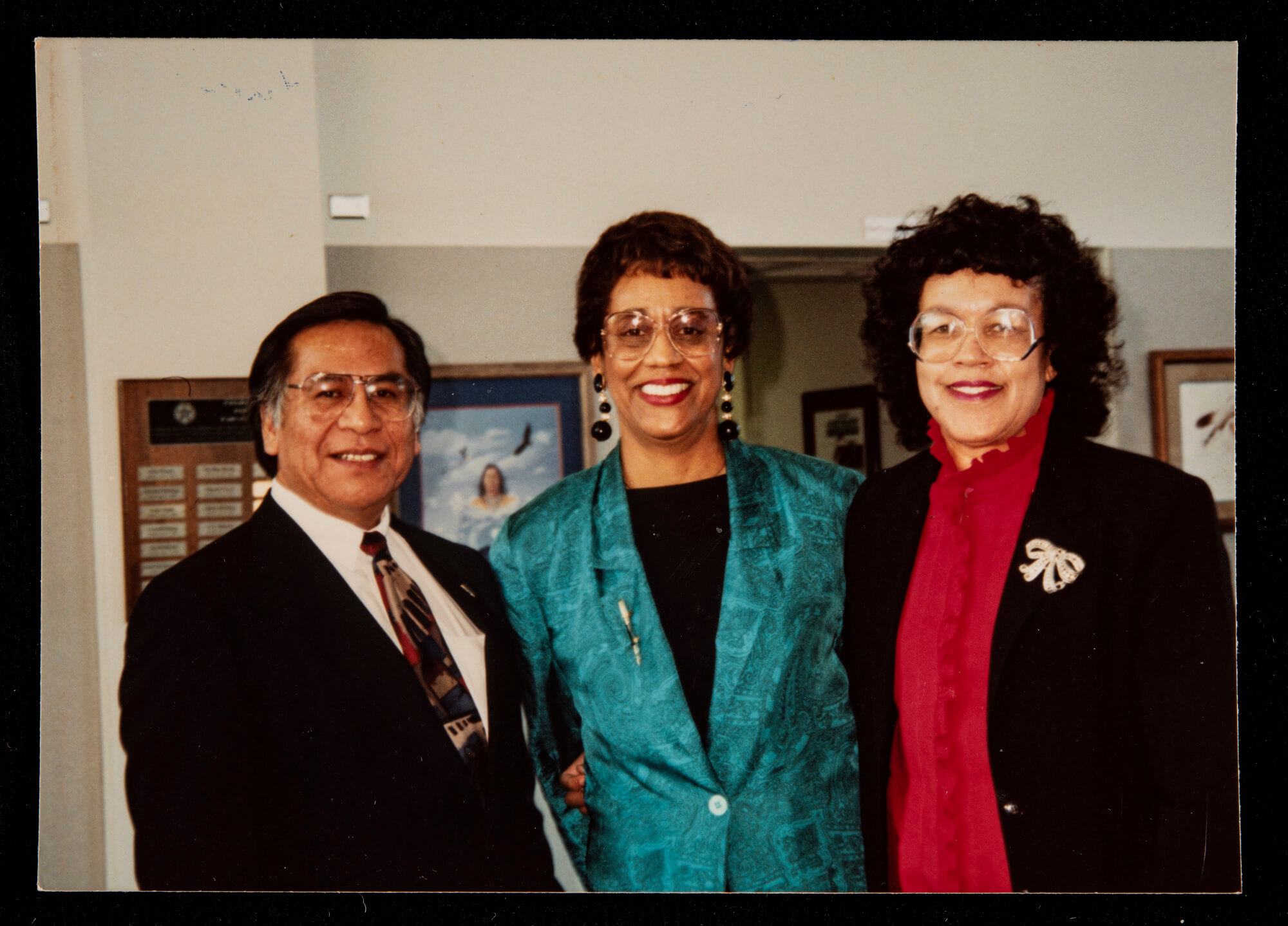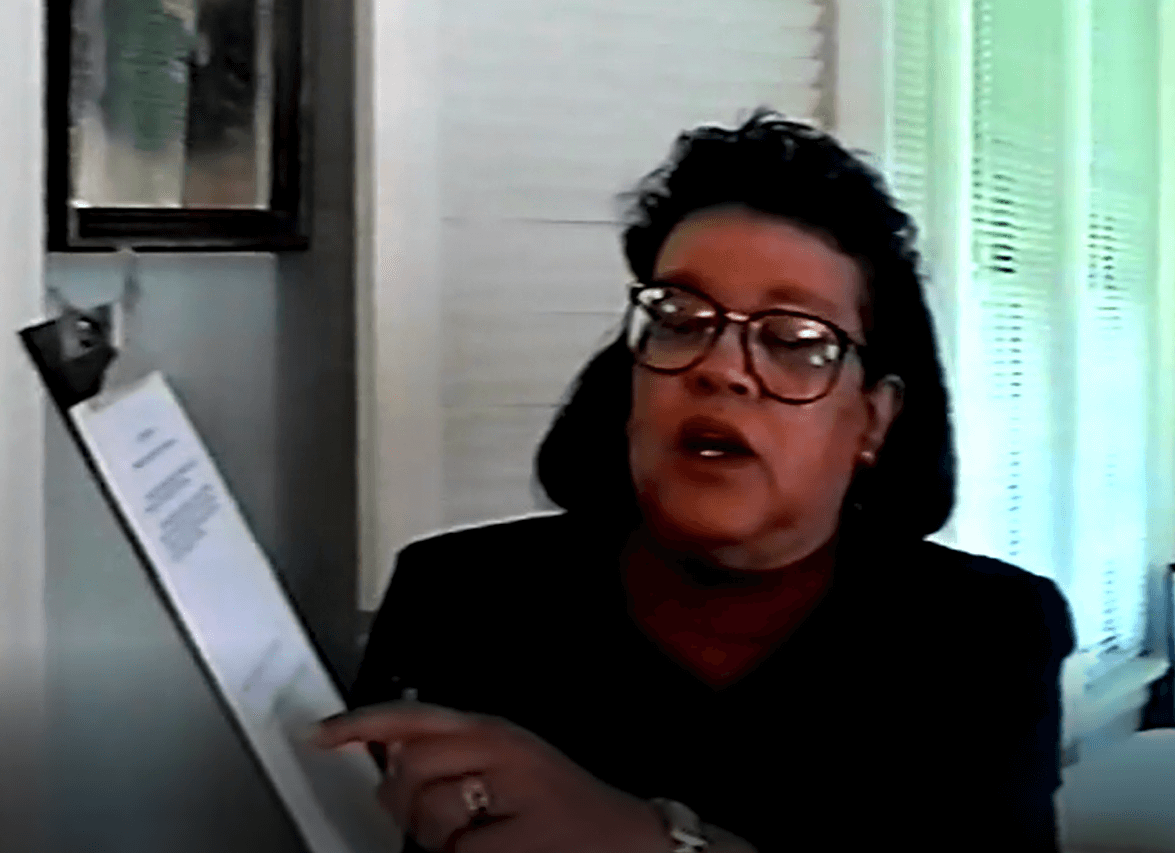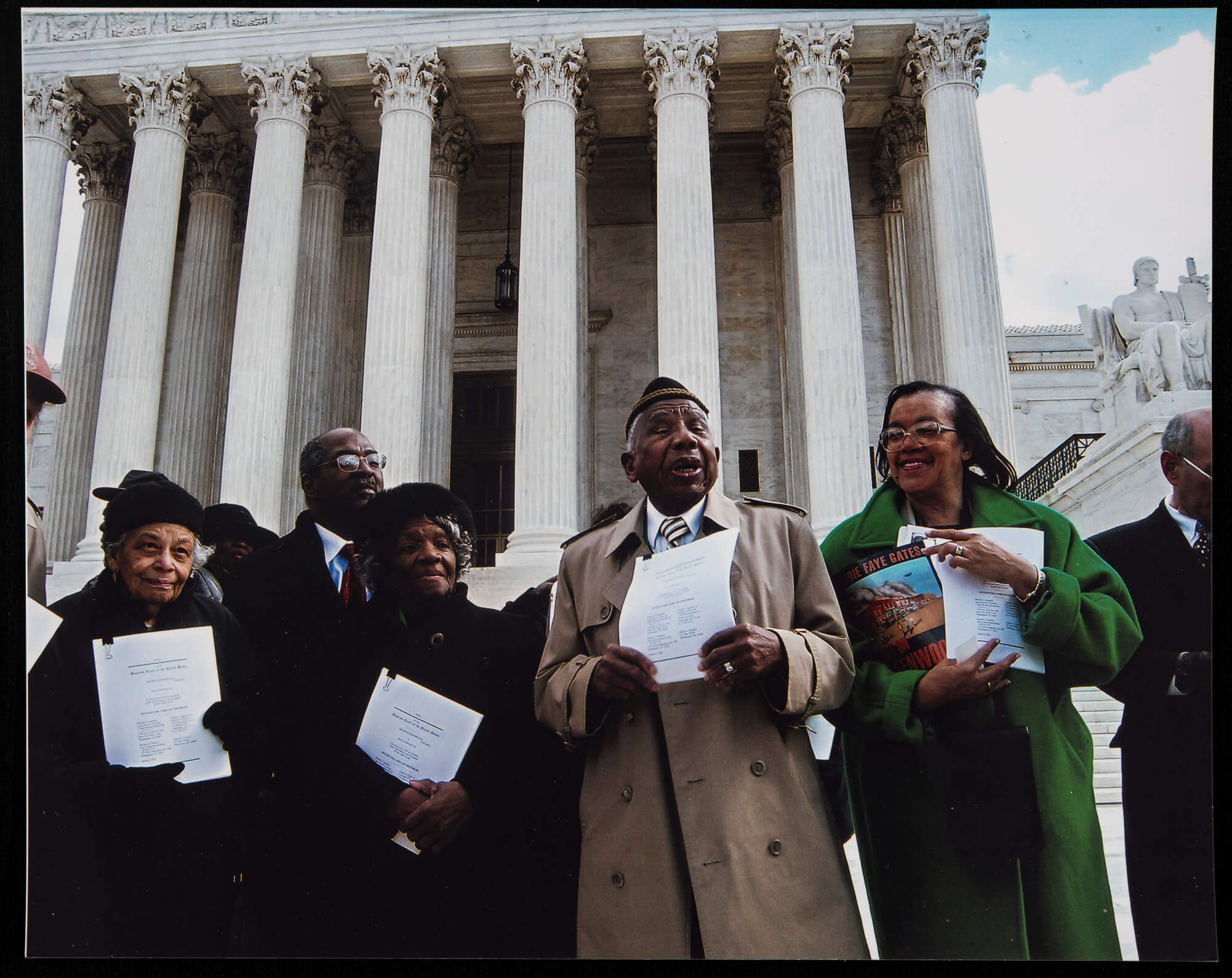Learning Objectives
- Students describe how a “conspiracy of silence” developed following the Tulsa Race Massacre and actions the Oklahoma Commission to Study the Tulsa Race Riot of 1921 took to uncover the history and consequences of the event.
- Students will use oral histories from Tulsa Race Massacre survivors to consider how history is written. They will explain that oral histories provide authentic perspectives of the Tulsa Race Massacre that are necessary for uncovering the truth about the massacre.
Guiding Questions
What role did the Oklahoma Commission to Study the Tulsa Race Massacre have in ending the “conspiracy of silence” around the massacre?
How can we learn about the Tulsa Race Massacre using oral histories from survivors?
Companion Collections

Senator Enoch K. Haney, Senator Maxine Horner and Eddie Faye Gates at the Greenwood Cultural Center in Tulsa, Oklahoma

Eddie Faye Gates with Don Ross holding a campaign sign running for State Representative

Tulsa Race Massacre Survivor Stories including interviews of George Monroe, Iola Streeter Jackson, Venice Dun Sims, Kinney Booker, and more
Background and preparations
Preparing for Complicated Conversations
The history of the Tulsa Race Massacre is one of violence and oppression, which has a lasting impact for many people. To be sensitive to your students and your own responses, teachers are encouraged to consider practices and strategies to implement before, during, and after instruction.
Teachers are encouraged to first consider their own comfort level in leading discussions on racially motivated violence and managing strong emotions. Before the lesson, teachers should also spend time thinking about the ways that they will support students as they engage in discussions and learning that is complicated and emotional. Teachers need to ensure the classroom is a safe place for all students. Classes should establish or review norms, even create a community agreement or provide students with sentence frames for agreeing or disagreeing with their peers.
During the conversations, teachers should be prepared to manage the strong emotions of their students. In doing so, they should check in with students about the emotional and academic progress. Further have students self-reflect to identify their emotions, build empathy, and self-regulate.
Following the lesson, students need time to process and reflect on these conversations, and time to process the emotions that may have arisen during discussion. There are many excellent resources available online to help develop classroom communities and manage complicated conversations.
A Change in Nomenclature from Riot to Massacre
Since the time the oral histories of Tulsa Race Massacre survivors were conducted by the Oklahoma Commission to Study the Tulsa Race Riot, a shift in nomenclature from “race riot” to “race massacre” occurred.
Why? According to the Tulsa Historical Society and Museum “historically it has been called the Tulsa Race Riot. Some say it was given that name at the time for insurance purposes. Designating it a riot prevented insurance companies from having to pay benefits to the people of Greenwood whose home and businesses were destroyed. It was common at that time [and is written in many textbooks] for any large scale clash between different racial or ethnic groups to be categorized as a “race riot.’”
For greater historical accuracy, and to avoid wrongly placing blame for the massacre on the community of Greenwood, a shift from the term “race riot” to “race massacre” occurred. In 2018, the Commission changed their name from race riot to race massacre.
Elwood Lett Video & Racial Slur
Teachers should note during Elwood Lett’s testimony he uses the “n” word when explaining the racial violence he experienced during the massacre. Teachers are encouraged to provide students with a warning of the use of this word prior to watching the video.
Handouts
- Talking Past the Silence Student Note Catcher
- Note Catcher Answer Key
- Conspiracy of Silence handout and Eddie Faye Gates Collection photographs 4327.10825 and 4327.10453
- S-I-T Teaching Strategy from Facing History
- Biographies of Eddie Faye Gates, Don Ross, and Maxine Horner
Companion Videos
- Tulsa Race Massacre Survivors’ Stories, Part 1 with Eddie Faye Gates Video Clips:
- Oral Histories: Interviews with Tulsa Race Massacre survivors Elwood Lett, Eldoris McCondichie, and Essie Beck:
Activities
Cover-Up Think-Pair-Share
1. Think-Pair-Share Prompt– Why do people choose to cover-up an event? Why do people sometimes hide the truth about their history or choose to not share something bad that happened to them?
2. Transition– Say- Following the Tulsa Race Massacre there was a cover-up in which city officials and community members hid evidence and silenced community discussions of the event. Survivors of the race massacre also had limited conversations about the event. The cover-up was so successful that 75 years after it happened, many Tulsans had not even heard about it. We will be investigating how the truth of the Tulsa Race Massacre was uncovered.
Background Information
1. Reading – students read “Conspiracy of Silence” handout and complete the reading questions on the student note catcher.
2. Discussion– ask students to discuss their responses to the reading questions. Answers to the questions can be found on the Note Catcher Answer Key.
3. Transition– say, Now we are going to listen to an account of how the Oklahoma Commission to Study the Tulsa Race Riot of 1921 went about working to uncover the truth of the massacre.
Oklahoma Commission to Study the Tulsa Race Riot of 1921
Tulsa Race Massacre Survivors’ Stories, Part 1 with Eddie Faye Gates Video Clips:
5327.1686_eddie1.m4v (4:29)
5327.1686_eddie2.m4v (1:49)
1. Watch the video from Commissioner Eddie Faye Gates. Have students answer the corresponding video questions on their note catcher.
2. Discussion– ask students to discuss their responses to the video questions. Answers to the questions can be found on the Note Catcher Answer Key.
3. Transition– say, Now we are going to listen to oral histories from several of the survivors of the massacre recorded by the Commission.
Oral Histories: Interviews with Tulsa Race Massacre survivors Elwood Lett, Eldoris McCondichie, and Essie Beck:
Video Clips:
5327.1686_lett1m4v (7:47)
5327.1685_eldoris1.m4v (4:51)
5327.1685_eldoris2.m4v (2:02)
5327.1685_eldoris3.m4v (0:23)
5327.1685_essie1.m4v (1:47)
5327.1685_essie2.m4v (1:12)
5327.1685_essie3.m4v (1:44)
1. Listening Protocol- Instruct students to fill out the oral histories portion of the note catcher. To do so, students must identify how each survivor describes their experience in the massacre, the impact it had on their life, and whether or not they had discussed the massacre with their families. An answer key is provided.
Note: During Elwood Lett’s testimony he uses the “n” word when explaining the racial violence he experienced during the massacre. Teachers are encouraged to provide students with a warning of the use of this word prior to watching the video.
2. Listening- Students listen to the videos either independently or as a whole class. Alternatively, teachers could have students listen to just one of the stories and then jigsaw the information in small groups.
S-I-T Reflection & Discussion of Oral Histories
1. Writing Prompt– Students journal on the S-I-T prompt in their note catcher.
2. Small Group– In small groups students share their S-I-T responses.
3. Discussion– Then, engage in a class discussion using the following prompts:
- What were similarities and differences in the accounts of the survivors? Consider how the massacre impacted their lives, as well as whether or not they discussed the massacre with their families, and why.
- What are the advantages of using oral histories? What are their limitations?
- What can we learn about the Tulsa Race Massacre from the oral histories of the survivors?
Below are talking points for the discussion:
- Oral histories are not perfect “windows” to the past. Time can change what a person remembers. Time can also help people feel more comfortable sharing information, so they can be more honest in their account.
- The survivors’ oral histories provide space to hear authentic perspectives on the Tulsa Race Massacre. In the case of uncovering the history of the Tulsa Race Massacre, authentic perspectives are essential since the voices of Black Tulsans were intentionally silenced and many of the documents about the massacre were destroyed.
- The testimony of the survivors can be used to corroborate with other sources and to help identify valuable details of what transpired.
- The oral histories are also part of the healing process, since they open up dialogue necessary for acknowledgment, repentance, reconciliation, and closure.
Assessment
Student Reflection
On their Note Catcher, students will write a response to the guiding questions.
Extensions
Students review biographies of Eddie Faye Gates, Don Ross and Maxine Horner and describe their efforts in supporting the work of the Commission.
Bibliography
“1921 Tulsa Race Massacre.” Tulsa Historical Society & Museum, www.tulsahistory.org/exhibit/1921-tulsa-race-massacre/.
“The Case for Reparations in Tulsa, Oklahoma.” Human Rights Watch, 28 Oct. 2020, www.hrw.org/news/2020/05/29/case-reparations-tulsa-oklahoma#_Toc41573966.
Clark, Alexis. “How the Tulsa Race Massacre Was Covered Up.” History.com, A&E Television Networks, 27 Jan. 2021, https://www.history.com/news/tulsa-race-massacre-cover-up.
Gates, Eddie Faye. Riot on Greenwood: the Total Destruction of Black Wall Street, 1921, Out on a Limb Publishing, 2006, pp. 30.
Johnson, Hannibal B. Black Wall Street 100: an American City Grapples with Its Historical Racial Trauma. Eakin Press, 2020.
Johnson, Hannibal B. Black Wall Street: from Riot to Renaissance in Tulsa’s Historic Greenwood
District. Lightning Source Inc., 2013.
Let’s Talk Facilitating Critical Conversations with Students, Learning for Justice, 2019.
Modifications
- For students who struggle to understand the videos in this section, teachers may show the videos twice using the following steps. 1.) Have students listen to the video. 2.) Discuss the video’s important points. 3.) Review the questions on the oral histories portion of the student note catcher. 4.) Watch the video a second time while having students complete the answers in the guide.
- To assist students who may struggle on the assessment portion of the lesson, provide students with sentence frames, also known as linguistic frames. This is a partially completed sentence or paragraph that students “fill in” orally or in writing.
Content standards
Oklahoma Academic Standards and Social Studies Practices
OKH.5.2 Examine multiple points of view regarding the evolution of race relations in Oklahoma, including: D) emergence of “Black Wall Street” in the Greenwood District; and E) causes of the Tulsa Race Riot and its continued social and economic impact.
3.A.9-12.1 Gather, organize, and analyze various kinds of primary and secondary source evidence on related topics, evaluating the credibility of sources.
4.A.9-12.1 Cite specific textual evidence to support analysis of primary and secondary sources, evaluating features such as author, date, and origin of information.
C3 Framework
D2.His.8.9-12. Analyze how current interpretations of the past are limited by the extent to which available historical sources represent perspectives of people at the time.
D2.His.14.9-12. Analyze multiple and complex causes and effects of events in the past.

